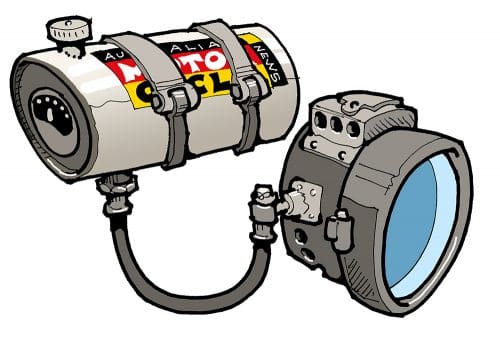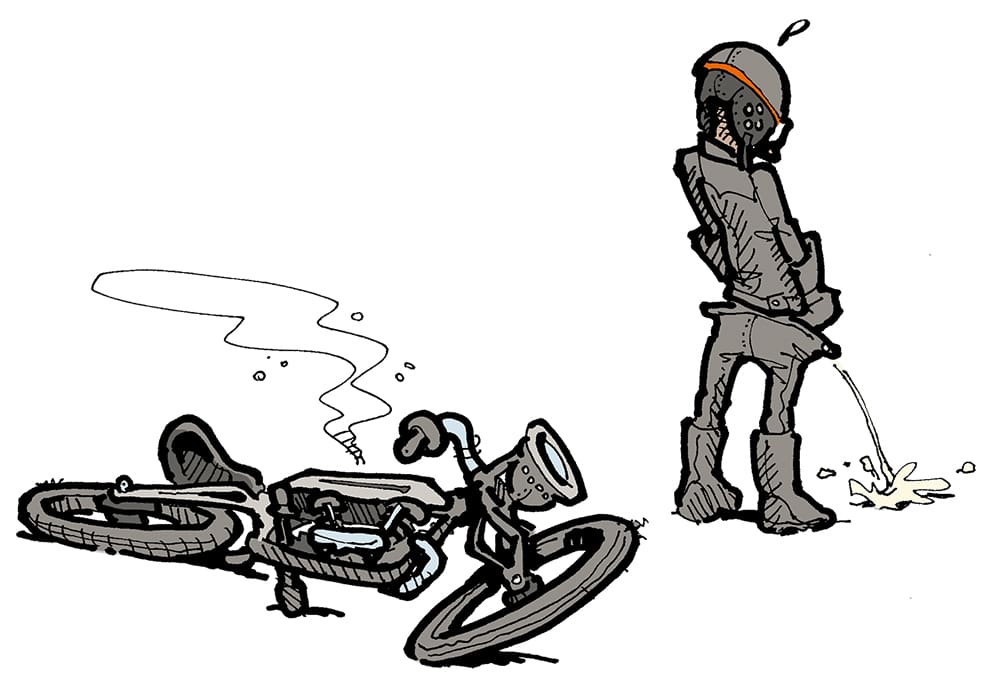So when George Patterson – the British Lightweight TT Champion – arrived on our shores to demonstrate the abilities of the 2.5hp ‘New Hudson’, he found that the 24-hour record was the talk of the trade and vowed to win the title for the Mother Country. Taking advantage of the summer twilight, Patterson’s attempt was flagged off at 4.45pm on 28 February, 1912, over an 84-mile (135km) triangular course plotted through the Western Districts of Victoria; from Camperdown, north to Lismore, west to Mortlake, then back to Camperdown.
Completing his first lap at an average speed of 37mph (60km/h), Patterson felt he could improve by changing gear ratios but his second lap was marred by blocked oil passages due to a disintegrating rubber seal. The problem was easily rectified and Patterson pushed off into the pitch dark. Only a few miles later, the lid of the acetylene lamp’s water tank fell off and the lamp began to fade, though Patterson completed his third lap. And he’d almost completed the fourth when the New Hudson’s lamp failed completely, just as he approached the only really sharp bend in the entire course. He rode straight into a stone wall completely wrecking the bike, but leaving him sufficiently mobile to walk the six miles back to Camperdown.

He returned a week later with a new New Hudson but fared no better. On his first lap, the petrol tank sprang a small leak. Refuelled, Patterson pressed on and only just completed the second lap before running out of fuel altogether. Then the headlight failed.
Despite these problems he took off on his third lap but after three hours had not reappeared. He was found at dawn not far from Lismore, the New Hudson with a seized engine due to a broken oil pipe. Yet another new New Hudson – this one a 3.5hp – was quickly on the scene and, in a desperate attempt to make up time, Patterson cut a lap at an average of 42mph (68km/h) just before the rear tyre blew, throwing him down the road. Undeterred, he quickly installed a new tube to complete the 24-hour ride.
Even after spending six hours off the machine, Patterson covered 547 miles (880km), which demonstrated what might have been, had not the use of two machines negated any claim of a solo continuous record).
The effort enthused the British Champion and the local New Hudson representative George Palmer enough to return for a third attempt. Their enthusiasm waned when they heard a new World Record of 724 miles (1165km) had been accomplished in Great Britain, though details were vague.
So Richardson’s record of 510 miles still held. Or did it?
A Phil O’Brien was rumoured to have upped this to 517 miles (832km) in April, though hard facts were difficult to come by. It mattered not, for during the first week of June, Will Peverill – holder of the Australian motorcycle long distance record for his epic ride from Melbourne to Brisbane and return – totted up 522 miles (840km) riding back and forth between the pubs at Keilor and Gisborne on what is now Victoria’s Calder Highway. Without the benefit of long twilight hours, Peverill did most of his riding in darkness, exacerbated by problems with the acetylene lamps on his 3½hp Peerless.
In the dawning hours, Peverill was suffering hypothermia so acutely he had to be lifted on and off his machine during refuels. Hot coffee, beef tea and chocolate were supplied on these occasions but it’s a safe bet the timekeepers on each end of the 25-mile (40km) course were fortified with something far stronger. The attempt almost came to a premature conclusion when Peverill hit a cow, causing considerable damage to the Peerless, losing more than two hours.

Then – according to the Melbourne Argus – in October 1912, a bloke by the name of Percy Yeend mounted on a 4¼hp Pivot took to the Mortlake circuit and was on schedule to break both the Australian and world records at the 11-hour mark when a valve cap let go. Less than two hours after being towed back to Camperdown Yeend continued his quest. Only much much later did Yeend claim a record of 629¼ miles (1012.28km), though it seems this was never authenticated.
Then, as if from the wilderness, came a claim from a Fred Custance, who’d ridden 523 miles (841km) in November 1912 on a circuit mapped around South Australia’s Yorke Peninsula.
It’s possible this news took time to reach Victoria, however all claims were laid to rest with the official return of Phil O’Brien, backed by Dunlop and the British Imperial Oil Company. When the clocks stopped at 6.50pm on Monday 3 March, 1913, O’Brien had recorded 686 miles (1104km) in 24 hours.
One would think that by then most enthusiasts would have had enough, especially the citizens of Mortlake, Camperdown, Lismore, Kielor and Gisborne. Then again these special occasions provided a great reason for publicans to extend their hospitality for keen spectators to have one more for the road.

Over in South Australia, it was more likely a BYO event for the large crowd who witnessed George Ramsey record 836 miles (1345km) in the course of a full day on the lonely, windswept Yorke Peninsula. Then, only an hour after Ramsey dismounted from his 3hp water-cooled Lewis, Rudge-mounted Carl Korner roosted off on the same 38 mile course and, 24 hours later, had added 35.5 miles (57km) to the record in front of a crowd estimated at 3000 hardy souls. This must have been somewhat a record in itself, though it was never stated how many of these enthusiasts were there for the entire 48-hour double bill.
However only a few weeks later Ramsey struck back. After riding 541 miles (870km) in 16 hours, he was forced to retire with a broken valve. Thus Korner’s record held and was claimed to be a world first, though the only news from Europe was that of the impending war.
In 1916 the legendary Edwin ‘Cannonball’ Baker arrived on our shores to promote the new Indian V-twin and surveyed a 33-mile course around the back blocks of Mortlake. Despite his Indian’s frame breaking during the attempt – welded by a local blacksmith en route – Cannonball upped the World Record to 1028 miles (1654km) before his oil tank ruptured at the 22-hour mark.
Upon his return to the USA, Cannonball commented “it was the toughest ride I ever took. I was petrified in Australia. That is the only word I can think of to describe it.
“From one o’clock in the morning the rain came down in buckets. My leathers were soaked to the consistency of messy glue. After the rain stopped, the hot January sun turned on all its burners. Riding in a cramped position crouched low over the handlebars, my leathers began shrinking and getting tighter.
“After a few hours I was literally baked into what had become a suit of armour. When they lifted me off the cycle at the end of the run I was as rigid as a mummy and they had to cut me out of the suit.”
Australia struck back in early spring 1920 when, in an outstanding feat of endurance, Harold ‘Ranji’ Parsons rode precisely 1114.5 miles (1793.6km) in 24 hours. And this over a rough gravel 23-mile course that included such notable sections as the gradients of Garden Hill and a whoop-di-doo named The Big Dipper. It also entailed negotiating the notorious hairpin bend overlooked by the Turf Hotel, which had applied for and been granted a 24-hour licence for the occasion and in which, no doubt, many other records were broken.
Jim Scoones – a very young lad at the time – was a passenger in his father’s straight eight Buick that was following Ranji on the final lap of his successful world record attempt. The Buick was carrying the official timekeepers, who had stopped to mark the roadway at the point Ranji had reached when the clocks hit the 24-hour mark, after which they chased Ranji down.
Eventually the officials waved for him to stop, and Ranji dismounted for the final time, before demonstrating his relief that the long ordeal was finally over.
“Ranji took the longest piss I’d ever witnessed,” grinned Jim.












